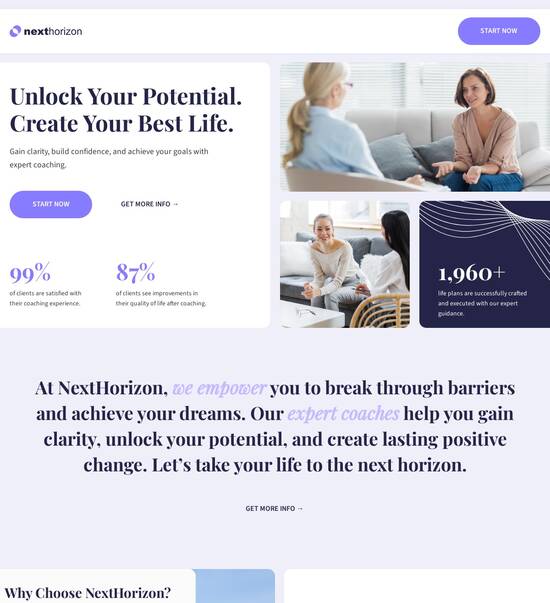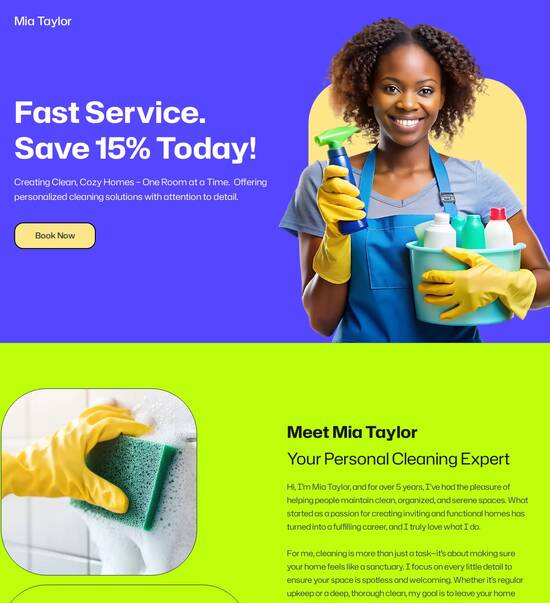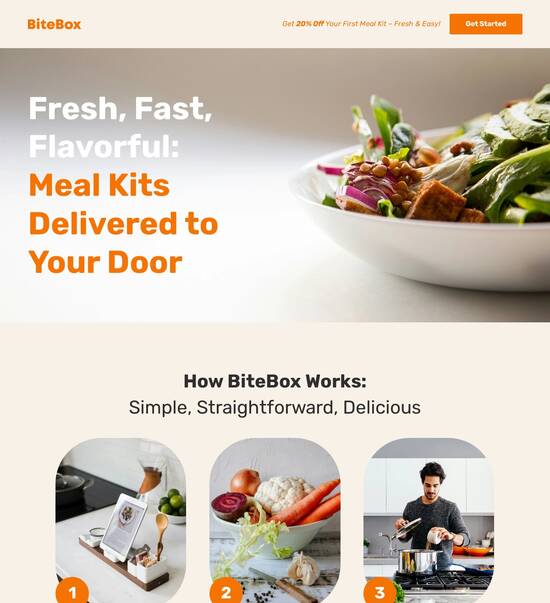
Design Microsoft Edge-ready feed page templates
Explore Similar TemplatesAbout template
Choose the best feed page template for Microsoft Edge
Recommended templates

Easy to build without coding
With the intuitive drag-and-drop builder, anyone on your team can create high-converting pages without any knowledge of code or design. Make enhancements to your landing page with custom widgets using Javascript, HTML/CSS, or third-party scripts.

Multiple layouts for any industry and goal
Select from 500+ landing page layouts built to boost conversions across industry-specific scenarios. Customize them by adjusting fonts, adding images, and generating on-brand content with the AI assistant. Quickly scale with Instablocks® and Global Blocks that you can save, reuse, and update globally.

Loads fast and looks polished on any device
Every template is responsive, which means they present professionally on any device and load blazingly fast with our Thor Render Engine. You can also power them up with Google AMP technology to deliver an unparalleled mobile experience and drive higher conversions.

Robust analytics & experimentation
Get real-time updates and reporting across all your devices, showing the number of visitors, conversions, cost-per-visitor, and cost-per-lead. Launch AI-powered experiments, run A/B tests, and use heatmaps to analyze user behavior, then optimize your landing page to maximize conversions.







Easy to build without coding
With the intuitive drag-and-drop builder, anyone on your team can create high-converting pages without any knowledge of code or design. Make enhancements to your landing page with custom widgets using Javascript, HTML/CSS, or third-party scripts.
Multiple layouts for any industry and goal
Select from 500+ landing page layouts built to boost conversions across industry-specific scenarios. Customize them by adjusting fonts, adding images, and generating on-brand content with the AI assistant. Quickly scale with Instablocks® and Global Blocks that you can save, reuse, and update globally.
Loads fast and looks polished on any device
Every template is responsive, which means they present professionally on any device and load blazingly fast with our Thor Render Engine.
Robust analytics & experimentation
Get real-time updates and reporting across all your devices, showing the number of visitors, conversions, cost-per-visitor, and cost-per-lead. Launch AI-powered experiments, run A/B tests, and use heatmaps to analyze user behavior, then optimize your landing page to maximize conversions.
All the features you need to build lead-generating landing pages
Explore more featuresLearn how to build top-performing landing pages for any goal
FAQs
Leading the way in building high-performing landing pages





A comprehensive guide to using Instapage for optimizing landing pages and boosting CRO
In the fast-paced world of digital marketing, using an effective landing page is crucial for capturing leads and maximizing ROI. Instapage stands out as a powerful all-in-one platform, enabling marketers from various sectors in the USA to design, optimize, and launch high-converting landing pages with ease. This guide outlines the essential steps to harness the full potential of Instapage for your campaigns.
Understanding the power of Instapage
Instapage provides marketers with access to over 100 pre-designed landing page templates tailored for various industries, including Business Services, Marketing, and Education. The platform's intuitive drag-and-drop builder allows teams of all sizes to create unique pages without the need for coding skills. Here’s how you can make the most of these templates.
- Choose a template that aligns with your campaign goals — Select from conversion-focused layouts specific to your target audience.
- Customize content easily using the intuitive builder — Modify text, images, and call-to-actions to fit your brand identity.
- Implement lead generation elements instantly — With pre-built forms and buttons designed for conversions, you can ensure you capture every lead.
Optimizing landing pages for maximum conversion
To boost the effectiveness of your landing pages, Instapage offers built-in optimization tools. Follow these steps to ensure higher conversion rates.
- Utilize A/B testing — Test different versions of your landing page to identify which elements drive the highest conversions.
- Analyze user behavior with heatmaps — Understand how visitors interact with your page to make informed adjustments.
- Conduct detailed performance assessments — Use Instapage’s analytics dashboard to measure success and refine your strategies.
Personalizing user experiences
Creating customized experiences for your audience can significantly enhance engagement and conversion rates. Instapage allows you to deliver personalized content through dynamic text replacement and the AdMap feature.
- Leverage dynamic text replacement — Automatically adjust content on your landing pages to match the keywords of your ads.
- Align specific ads to dedicated landing pages — Use AdMaps to ensure that visitors find exactly what they're looking for, based on their traffic sources.
- Track performance at the audience level — Use integrated data tools to analyze how different audience segments interact with your content.
With these strategies in mind, you can create landing pages that not only attract but convert leads effectively. Collaboration features also make it easier to work with your team and stakeholders to produce exceptional pages.
In conclusion, investing time in optimizing your landing pages through Instapage is necessary for any marketing strategy aimed at maximizing ROI. Whether you’re in Tech, Education, or Financial Services, this guide will help you navigate the platform effectively.
To start optimizing your digital marketing campaigns, sign up for Instapage now and step into the future of high-converting landing pages.
People also ask about Feed page template optimized for Microsoft Edge
Unveiling the feed page template optimized for Microsoft Edge
Understanding the importance of feed page templates
Feed page templates serve a crucial role in digital content delivery. They are essentially pre-designed frameworks that simplify the process of creating and maintaining web pages. Their primary purpose is to present information, updates, or multimedia content in an organized, visually appealing manner. For users, this means engaging with content that's easily accessible and navigable.
The optimization of these templates for Microsoft Edge enhances user experiences by capitalizing on the browser's unique features, such as its performance capabilities and user-friendly interface. These templates not only streamline design and development processes but also ensure that content resonates well with users through thoughtful presentation. In modern web design, technology greatly shapes overall user interaction, making it essential to align templates with the latest standards.
Key features of the optimized feed page template
When designing an optimized feed page template, several key features must be prioritized to ensure maximum effectiveness. First and foremost, responsive design principles must be applied. This involves creating layouts that adapt seamlessly to different screen sizes, catering especially to mobile users. A mobile-first approach not only improves access for a wider audience but also increases engagement through fluid navigation.
Benefits of a mobile-first approach: This strategy focuses on optimizing aspects for mobile devices before scaling up for desktop, leading to simplified forms, smaller images, and less navigation complexity.
Exploring grid layout adaptability: A grid system allows for alignment and organization of content, facilitating clarity for users who browse on different devices.
In addition to responsiveness, performance enhancements play a vital role in the effectiveness of feed page templates. By utilizing Microsoft Edge's capabilities, such as aggressive caching and improved JavaScript execution, designers can ensure quicker load times. CSS optimizations further contribute to a smoother experience, minimizing the frustration often encountered with lagging pages.
Accessibility and usability are two more significant factors that cannot be overlooked. Designing for diverse communities is essential to reach a broader audience. This means implementing best practices for screen capture, ensuring that crucial content is easily detectable and usable by Edge users.
Exploring innovative capabilities
Innovative capabilities in feed page templates represent a forward-thinking approach to web design. One critical aspect is the integration of advanced web technologies such as CSS, HTML5, and JavaScript, which enhances the template's interactivity and aesthetic appeal. By leveraging features specific to Microsoft Edge, developers can improve functionality, such as utilizing the browser's built-in tools for responsive design previews and inspection.
Integrating web technologies: The use of CSS for styling and JavaScript for interactive elements enhances user storytelling.
Making use of Edge’s built-in tools: Tools like the developer console allow for immediate feedback and adjustments, improving efficiency in the design process.
Another important aspect of these templates is the peer-driven enhancements that lead to continual improvement. Communities often contribute their insights and suggestions, helping to refine template designs. This collaborative process encourages learning from collective knowledge through Q&A sessions and feedback loops, driving ongoing innovation.
Collaborative development processes
The development of optimized feed page templates heavily relies on collaborative processes. Engaging teams from different backgrounds enables the crafting of more versatile and effective templates. Structuring workflows to facilitate effective collaboration is paramount. Tools like project management software and shared digital workspaces allow for real-time edits and feedback, speeding up the production process.
Engaging teams in template creation: Diverse perspectives enhance creativity and functionality, addressing various user needs.
The role of user testing: Pilot programs facilitate the analysis of real-world usage and identify areas for improvement.
User testing is integral to the development process as it provides firsthand insights into how users interact with the templates. Conducting Q&A sessions with target audiences allows for the collection of actionable feedback, which is crucial for making informed adjustments that enhance usability.
Navigating content structure and layout
Crafting compelling content within the feed page template is essential. Utilizing strategies and language that resonate with targeted demographics ensures that users feel a connection to the content. Effective storytelling, especially within the grid layout, offers a way to engage users and maintain their attention.
Strategies for language: Understanding the audience's preferences enables more relatable and relevant content creation.
Importance of storytelling: Engaging users through narratives encourages exploration of the template.
Moreover, establishing visual hierarchies ensures that critical information is easily discernible. A well-organized grid system helps achieve informational clarity, allowing users to absorb content efficiently. Designers must balance text, visuals, and interactive elements, tailoring this balance specifically for Edge users, optimizing their browsing experience.
Optimization techniques for maximum efficiency
To maximize the efficiency of feed page templates, data-driven decision-making is imperative. Leveraging location-based analytics can help refine landing pages to suit regional preferences and trends. Monitoring user behavior and examining usage patterns enable designers to adjust templates based on real-time data, ensuring optimal performance.
Using location-based analytics: This helps in tailoring content to diverse user locations, improving relevance and engagement.
Implementing SEO best practices: Ensuring content is optimized for discoverability increases the visibility of landing pages.
Additionally, implementing SEO best practices is essential in optimizing landing pages. Creating content that marries creative flow with search engine discoverability allows marketers to reach sought-after demographics effectively. Leveraging insights from Edge's performance tools can further aid in fine-tuning these optimizations.
Addressing common challenges in feed page optimization
The optimization process isn't without its challenges. Identifying and troubleshooting common user issues is a critical step in ensuring continued engagement with the template. Frequently recurring user questions and concerns should be recognized proactively, allowing teams to implement preventive measures for design flaws before they escalate.
Identifying frequent user questions: A structured approach to gathering this data allows for targeted improvements.
Adapting to user feedback: Categorizing responses facilitates straightforward adjustments in the template design process.
Adapting to user feedback is another essential aspect of optimization. By collecting and categorizing insights from user communities, developers can foster iterative enhancements. This approach allows for a feedback loop, where developers continually adapt feed pages based on user input and overall resource accessibility, thus refining the user experience.
Looking forward: The future of feed page templates
Looking ahead, the evolution of feed page templates will be influenced by emerging trends in web design. With Microsoft Edge consistently releasing updates and enhancements, staying ahead of the curve is vital for marketers. Anticipating these advancements and adjusting templates accordingly will play a significant role in ensuring effectiveness over time.
Anticipating advancements in Microsoft Edge: Monitoring browser updates will inform design strategies.
Fostering innovation through collaboration: Encouraging input from diverse tech collectives will enhance template effectiveness.
Collaboration, both within teams and in broader tech communities, will continue to be a driving force behind the innovation of feed page templates. By leveraging diverse perspectives and experiences, developers can enhance template functionality and fit the evolving needs of users, ensuring these templates remain relevant and effective for future use.
Ready to skyrocket conversions?
Supercharge your ad campaigns with high-performing landing pages
Get started














